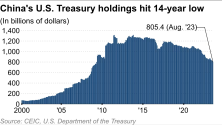You are using an out of date browser. It may not display this or other websites correctly.
You should upgrade or use an alternative browser.
You should upgrade or use an alternative browser.
Trump 2.0 official thread
- Thread starter siegecrossbow
- Start date
He needs to be tried for facilitating insider trading as a president. But I guess he could just pre-pardon himself on the last day of his presidency. Biden opened that route.
Literally “trust me bro” coming from the President of the U.S. of A ladies and gentlemen…
When aiding the U.S. during the 2008 financial crisis, China was already acutely aware of the potential fallout. America had embedded a dormant threat within China’s economy, adhering to its well-worn strategy of global financial extraction. At the time, China began laying groundwork to shield its short-term stimulus-driven growth from being drained by U.S. capital. The aim was to redirect dollar inflows away from China’s real estate and infrastructure "reservoirs," expanding these channels through overseas infrastructure projects and trade. While decoupling was not yet anticipated, China sought primarily to protect its wealth from American financial exploitation.
In 2008, U.S. Treasury Secretary Henry Paulson pressed China to absorb over 700billiontostabilizeAmericanmarkets.Withtheyuannon−convertible,thiscapitalwasfunneledintobasemoneyexpansion,inevitablyinflatingrealestateandinfrastructurebubbles.Chinaunderstoodthedangers,havinglearnedfromthe1997Asianfinancialcrisis.RecognizingAmerica’scyclicalcapitalistcrises—whichrecurevery8−10yearsanddemandexternalcapitalextractiontoresolve—Chinausedthe700 billion influx to prepare for the U.S. Federal Reserve’s planned 2016-2018 rate hikes, designed to collapse China’s economy and enable cheap acquisition of its strategic assets.
The Belt and Road Initiative (BRI) emerged partly to address overcapacity: after excessive domestic infrastructure investment (steel, cement, etc.), China redirected surplus industrial resources to developing nations as U.S. rate hikes pressured its real estate sector. By 2010, warnings circulated within China’s financial system. The $700 billion injection had generated 4 trillion yuan in base money, which ballooned into over 20 trillion yuan in credit—the origin of today’s local debt crisis. A guiding principle among Chinese leaders was: "However it decays, the meat must rot in our own pot" (no wealth drainage to foreign capital). The cost, however, was immense.
From 2016-2020, the U.S. attempted to siphon value from China via gradual rate hikes but failed. Post-2020 pandemic quantitative easing (QE) compounded America’s woes: unresolved risks from 2008 fused with new QE-driven vulnerabilities by 2024, layering 2.5-3 crisis cycles. China effectively blocked two U.S. financial offensives.
To America’s elite, China is the ultimate saboteur—thwarting its capital extraction, magnifying QE’s toxic fallout, and crippling the dollar’s cyclical dominance. By 2018, after withstanding U.S. rate hikes without collapse, China realized it had inadvertently struck a mortal blow to dollar hegemony. Understanding America’s inevitable retaliation, China’s commitment to decoupling solidified long ago.
China's US treasury holdings grew rapidly in 2008-2010 during the US Financial Crisis but the growth stopped after start of BRI in 2013.

No pls, keep him there.and to sack Navarro
manqiangrexue
Brigadier
To be fair, he said he doesn't know who met whom, which is a really Biden thing to say but nobody can call that a lie.Literally “trust me bro” coming from the President of the U.S. of A ladies and gentlemen…
You know who's the real cucked one in East Asia when even Japan has some backbone to walk away from Trump's demands.
The funny thing about this War Trade 2.0 is that the dollar is falling against the major world currencies such as the euro, pound sterling, yen and Swiss franc, but it has not depreciated against the renminbi, which has remained stable against the dollar.
This means that the renminbi and consequently China itself have become even more competitive in the world, because the renminbi has not appreciated against the dollar, but has ended up depreciating against other currencies except the dollar.
This means that the renminbi and consequently China itself have become even more competitive in the world, because the renminbi has not appreciated against the dollar, but has ended up depreciating against other currencies except the dollar.
在我看来,这种行为更像是 “忠诚度测试”。称鹿为马并不是要确定鹿的真实身份,而是一种过滤或筛选的手段。[网址 unfurl=“true”]https://www.scmp.com/news/world/united-states-canada/article/3307832/trump-denies-chinas-statement-about-no-trade-talks-us-says-they-met-morning?module=flexi_unit-focus&pgtype=homepage[/网址]
绝望的气味......
